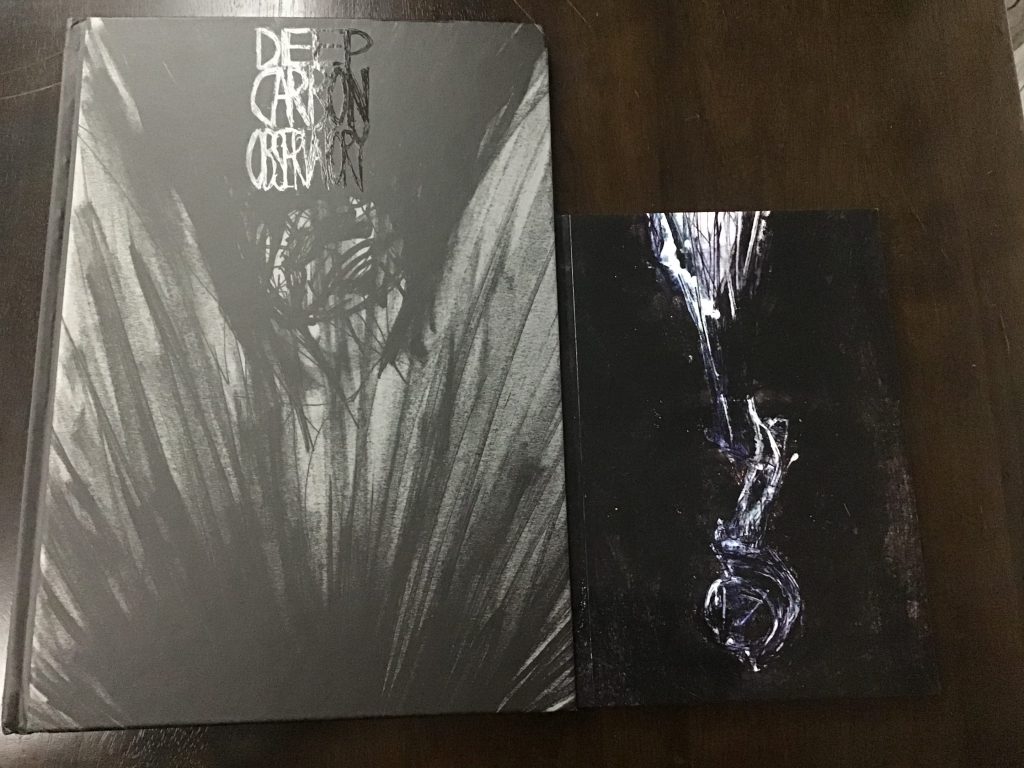Posted on June 22, 2020
Deep Carbon Observatory Remastered
I backed the Deep Carbon Observatory Remastered Kickstarter, and received the hard copy of my new book yesterday. I have never played Deep Carbon Observatory (either version) so this review is based on a reading only. I will start my review with a section aimed at those familiar with the original, and then move on with a section aimed at anyone, whether they are familiar with DCO or not.

What’s New?
The new book is an A4 hardcover, with glossy interior pages and two ribbons. Its layout preserves the aesthetic of the original but seems much more functional. Each spread is clearly numbered (in the top left and right corners), and the maps are keyed to each spread. The maps in the remastered version as much more legible than they were in the original, redrawn in isometric projections on much larger scales, at both the front and back of the book to be easy to reference in play. The spread numbers and keys on the map make it very easy to quickly flick between maps and the appropriate page. The Remastered book now features an index rich in detail (not just titles and page numbers, but including a very brief summary of key information). These features make the new book a great deal more functional than the original as a publication.
The book also features expanded content as opposed to the original. Once again, this new content has the effect of making the adventure substantially easier to use, in my personal view. I found the dive straight into the crisis of Carrowmore without any real context in the original DCO disorienting in my read through of the original book. The book now provides 30 different hooks, an introduction to DCO, how it should be run, intended character levels, and so on. Even once we move into the material which was there before (e.g. the 18 box “The Flood” flowchart), this material is made more usable with small enhancements to the content and formatting. The Crows are now stated more clearly for Lamentations of the Flame Princess and have clearer advice for the referee about how to run them. This pattern continues throughout the book, especially for the more important encounters.
The new maps from Dirk Detweiler Leichty and new, larger artwork from Scrap Princess now add much more visual interest to the Remastered book. The art style is consistent with the original but the size and improved printing quality has enhanced the effect considerably. The style may still remain divisive and is not necessarily for everyone – but for me, Scrap Princess captures the frenetic energy, the sense of despair and desperation which perfectly matches the write-ups of creatures and encounters in the module. I also really like the new maps by Dirk Detweiler Leichty – they are much more functional in play than the maps included in the original, and much more clearly communicate the three dimensional nature especially of the “dungeon” parts of the adventure. You can pick these up PWYW on DriveThruRPG right now (affiliate link) if you are fence sitting about the new remastered book and it might help you make up your mind.
If, like me, you were always interested in the original Deep Carbon Observatory and found the adventure compelling, but hesitated running it in your campaign because you didn’t find it sufficiently accessible to actually try running it, the remastered version is a worthy upgrade. I now definitely want to actually play this module, and feel that the new book will actually help me run it. In short, Deep Carbon Observatory now feels like it wants to be actually played. If you found the old version perfectly playable, and you already enjoyed it, though, then I think the question really is – do you want a “deluxe” version of the physical book? If you do, and you’re prepared to pay £25 for it, then the remastered DCO is there for you. Otherwise, you are probably fine keeping your existing book, and maybe just checking out the maps from the remastered version.
New to DCO?
Deep Carbon Observatory is an OSR adventure with a DIY, art house aesthetic by Patrick Stuart and Scrap Princess. It is a dark, bleak module, which starts off in a drowning town and finishes in an observatory at the bottom of a deep mineshaft carved out of the depths of the earth by slaves in aeons past. If they survive, the player characters will pick over the bones of a long dead civilization for its discarded and forgotten treasure. This is not Faerûn – this is grimdark survival horror fantasy.
The module describes itself as “theoretically survivable” for a level 1 party, but is aimed at a party of characters of levels 3 to 5. Most monsters and hostile NPCs have less than 5 HD, but the toughest enemies have more, and the biggest foe has 15 HD. As with most OSR games and adventures, the raw challenge rating of encounters is far from the full story about how challenging the adventure is likely to be. Player skill and strategy will be more important for success in DCO than player character levels and abilities.
Unlike the original version of the module, Deep Carbon Observatory‘s remastered edition has a number of compelling hooks for player characters. The ultimate objective is to reach an ancient magical gate deep within the earth, underneath a lake, upriver from the town of Carrowmore, and from there perhaps to escape with the treasure of an ancient empire.
The adventure starts with the characters on the scene of a natural disaster – this is an uncommon opening in adventure modules to say the least, and will certainly set the tone of darkness and despair as no matter what the players do they will be unable to save everybody. On the other hand, if your player characters don’t even try, as a referee you’ll know from the start that your PCs are amoral arseholes and maybe the tone of the rest of the adventure won’t affect them very much either. The adventure provides a flowchart-based approach for witnessing the various small human tragedies which comprise the flood of Carrowmore, and I believe this will create a dynamic and chaotic feeling in play as the players respond to some events and not to others, with consequences for both. It’s a unique opening to an adventure.
From this opening the adventure moves on to a race to the observatory through the devastated valley beyond Carrowmore, up the walls of the destroyed dam, and to the vast, ancient underground structure where the gate and the eponymous observatory lie. The race strikes me as both crucial to maintaining the pace of the adventure and as the part which will likely be the most difficult to run “as designed” in play. Players like being fully rested, with their full array of spells prepared, before they go into danger. To maintain a sense of desperation and keep that “survival horror” feeling established early on in the adventure, the players can’t be allowed to rest lightly. Any delay on their part must cost them. This is clearly the intention of the race as described in the book – rival adventuring parties (and other groups) are hot on their tails, and delays will lead to more challenges and complications in the form of dealing with these rival parties. Many players, especially those used to 5e D&D’s rest mechanics, will push back on this pressure and respond in ways which will lead them onto sidetracks – they refuse to be harried and will try to “take out” the pursuers so that they can approach the rest of the adventure at their leisure. Referees will need to play the rival parties and adversaries in the race “smart” in order to keep the pressure on, so that the party feels that the best direction for them to keep going is forward. Even then, a smart party knowing it is going to play a long term campaign which will last beyond the Deep Carbon Observatory module may reason that they may as well stop and fight their pursuers now, as otherwise they will have to fight them on their way back, when they will presumably be in substantially worse shape. There’s nothing wrong with the party succeeding at destroying its pursuers, of course, but it will mean there’s a lot less tension in the remainder of the adventure if they do so.
Where I find Deep Carbon Observatory most compelling is in its description and the exploration of the ancient structures left behind by the long extinct civilisation, and in the guardians that ancient culture has left behind. The description of the ancient culture’s structures and its guardians are compelling, but sometimes, only the referee will be able to properly appreciate this. The ancient golems, for example, are both ominous and tragic foes. They are slowly dying through the course of the adventure, and the longer the player characters take to meet the golems, the weaker the golems will be when they are encountered (all the more reason why the race must succeed at keeping up the pace!). Unfortunately, only the referee is likely to feel the sense of inevitable doom which makes these golems so compelling as an encounter. The golems, weakening day by day, are slowly dying. The player characters are unlikely to realise this – they’re going to encounter golems with x many hitpoints and that’s likely to be the only encounter they have with them. They will not realise that if they met the golems a day earlier, x would be larger, or if they had encountered them a day leater, x would be smaller – and this is a shame because the size of x is the only way a player character can directly observe the decay of these ancient servitors. The sense of ancient decay and despair will be more properly appreciated by the players in locations such as “The Slave Caves”, however, where the suffering and aeons of misery will be more directly observable.
There are very many great modules in the OSR scene where the adventurers themselves will rarely get more than glimpses of what is truly going on. This is not necessarily a problem – in fact, it rather helps the richness of the sense of mystery about an ancient dungeon if the players catch glimpses of it but the referee knows much more. If the details even the referee has are few and disjointed, however, then the players are more likely to be confused by the glimpses they get than they are to develop a sense of mystery and awe. It is my feeling that Deep Carbon Observatory belongs more in the former camp – that the players will finish the adventure with a sense of mystery, albeit one which they have only glimpsed in incomplete but compelling pieces. This is based only a reading, and not on actual play, so I may be proved wrong. I am, however, now determined to find out, which is the great success of the remastered Deep Carbon Observatory in my view – the compelling promise of the original has been developed into something which I now find playable and want very much to run.
Affiliate Links
You can get Deep Carbon Observatory from DriveThruRPG in PDF:
- Deep Carbon Observatory Remastered (but I recommend buying the book in print here – this not an affiliate link but it’s just better to have a hardcover book)
- Deep Carbon Observatory original – now pay what you want
- The remastered DCO maps
- Feast of Bukako – a free spellbook including all the spells mentioned in DCO
